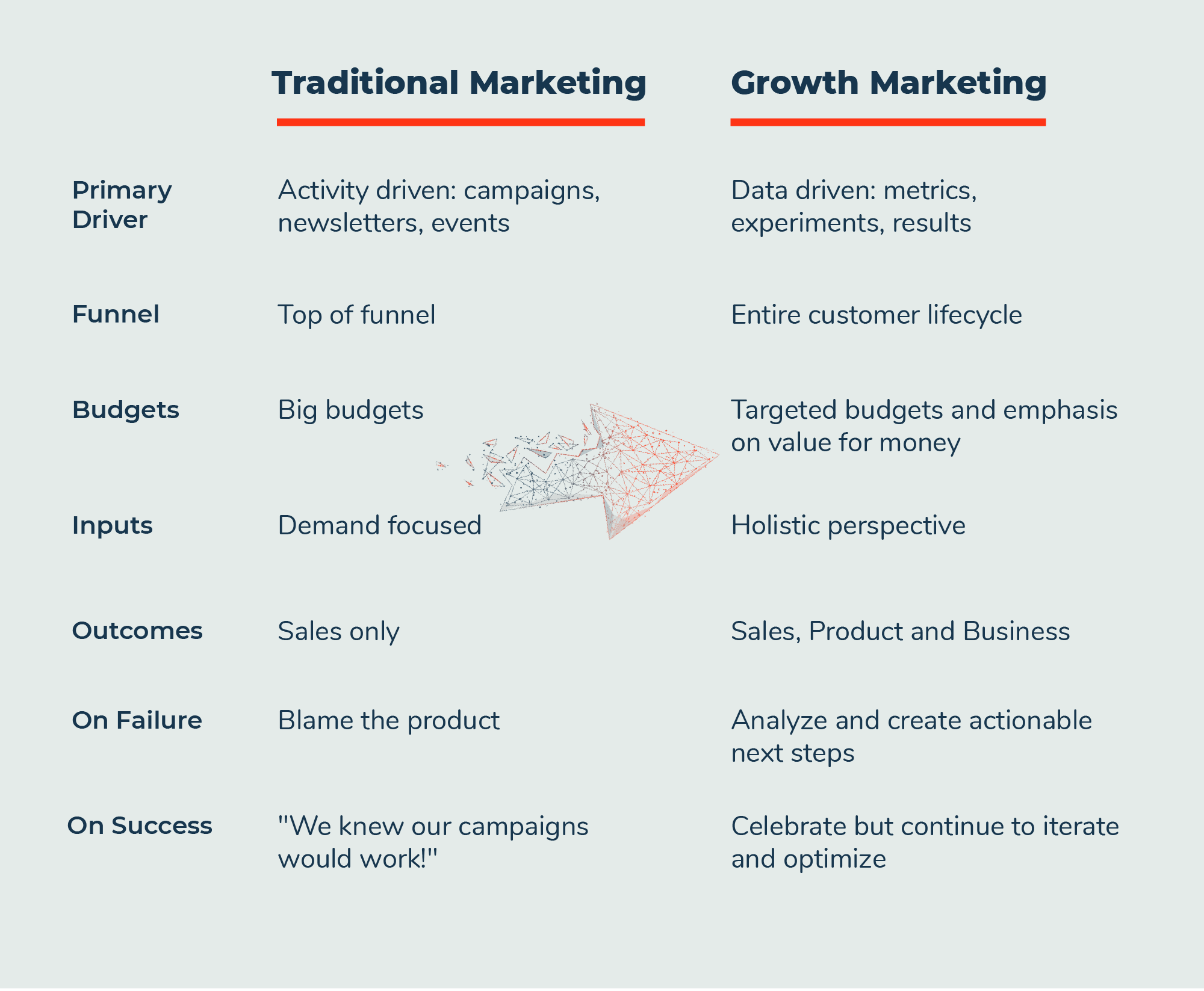What is growth marketing and why should you care?
Growth marketing is an insights-driven approach to acquisition that uses continuous experimentation to create positive outcomes for your business. Or in plain English, growth marketing involves coming up with ideas to grow revenue, creating experiments to test those ideas, and measuring outputs to make sure the desired results were achieved.
The term growth hacking was coined by serial entrepreneur Sean Ellis to describe innovative methods for attracting and converting customers at all stages of the sales funnel. He applied these methods with great success at companies like Dropbox and Eventbrite, and soon attracted hordes of enthusiastic fans. Eventually however, growth hacking became associated with spammy web scraping hacks and attempts to "trick" people into giving up their information. In reality, growth hacking is simply about running smart experiments to drive growth within your business.
Most of the things that most traditional marketers do are not really scrutinized by their impact on growth - Sean Ellis
Traditional marketing often focuses on branding and awareness campaigns, and returns can be hard to quantify. Growth marketers, on the other hand, identify opportunities at every stage of the funnel by analyzing the data and designing experiments to convert those opportunities into revenue.The "throw it at the wall and see what sticks" approach is anathema to a good growth marketer.
Traditional marketing vs growth marketing
Traditional marketing differs from growth marketing in several key ways.

Signs that you need a growth marketing solution
If you or someone on your team has said these words lately, you might want to consider a growth marketing solution or agency:
We have tons of data but we don't have time to do anything with it
I met this guy at a networking event and he said influencer (insert buzzword here) marketing will really juice our sales
Omni-channel strategies take time to show results. We just need to be patient
If we want more sales, we're going to have to increase our ad spend
Tips for starting your growth marketing journey

- The old adage, "You can't manage what you don't measure" still holds true. If you're not already doing this, start by analyzing every step of your funnel. Make sure you're capturing the key metrics that matter to your business. For example, CPL (cost per lead), CAC (customer acquisition cost), CLV (customer lifetime value), conversion rates, etc.
- Zone in on where the biggest drop-off is in your funnel. While data is important, don't ignore your intuition entirely. Talk to potential customers and try to understand why they're not converting. If you identify multiple drop-off points, prioritize one. Keep in mind that it's not just about quantity. Conversion rates on your landing page might look low, but think about what percentage of the people you're driving to it is actually qualified. Your true conversion rate could be higher than you think, and this might not be the best touchpoint to optimize.
- Once you've identified the opportunity, brainstorm ideas for how to improve it. Each idea should be testable, and results should be measurable.
- Next, design the tests and establish the definition of success. Think of it this way: if you and your team are drinking champagne because this campaign went well, how will you know when it's time to pop the cork? Let's say you know that visitors spend 2 minutes on your shiny new landing page, but they're not clicking the Call To Action button. You could try changing the copy or the button color to see if that makes a difference. A traditional marketer will make a bunch of changes and then hope for the best. If nothing changes, they might try another set of changes. A growth marketer, on the other hand, will design an A/B test and deliver Version A to one set of visitors and Version B to the other set. She will estimate that the winning experiment will increase conversion rates on that page by a certain percentage and then run the experiment until statistically significant results are available.
- Set measurable goals or Key Performance Indicators (KPIs). KPIs are the guideposts that tell us we're moving in the right direction. It's not enough to launch campaigns and cross your fingers. If you don't yet have baseline measurements, use industry statistics or competitive information to determine what a realistic goal should be. For example, if referred leads in your target market are known to convert 30% higher than non-referred leads, and you know your current conversion rate (which you should), you can come up with a goal for your new referral program. A bonus here is that hard metrics help get buy-in from leadership and speed up decision-making.
- Implement, launch, measure, iterate. Set up your experiment, run it, and capture results. If the experiment fails, acknowledge failure and analyze the causes and how you can address them. You could also decide to cut your losses and change strategies entirely. Failing early minimizes the time and effort spent on new strategies and enables you to take more risks, which in turn can bring greater benefits.
- Rinse and repeat. Most successful growth programs require continuous iteration and optimization. So when do you know you're done? What if you don't have the resources to manage all these different programs? If you're working with an agency, that's part of the service they provide. If you're doing it yourself with a small team, you can create processes to make it easier on yourself. Pull in all the data into a single dashboard so you can see at a glance how each program is performing. Schedule time to review each program at regular intervals, whether it's monthly or quarterly. If your loyalty program hit its objectives, take a minute to celebrate. Then, think about whether there's room for improvement. If not, monitor it in your dashboard to make sure it continues to stay on track, and add an event to the marketing calendar to revisit it in the future.
Popular growth marketing strategies and methodologies
While there are many growth strategies available, there are some tried and true elements that can guide you along the way.
- A/B testing: A/B testing (also known as split-testing) allows you to compare two or more variants of your web page to different segments of visitors at the same time so you can compare which variant drives more conversions. Multivariate testing allows you to test multiple versions at once but requires a lot of traffic to get statistically significant results. A/B tests are usually run for small changes and simple variants, such as changing the size or color of a call to action button to see which one gets more clicks.
- Referral programs: A lot of companies focus on advertising and search marketing for acquisition, but research has shown that customers who have been referred by a friend are four times as likely to buy. Referrals also have lower acquisition costs than other methods. At its most basic, a referral program involves giving an existing customer an incentive for referring their friends and colleagues. However, this isn't always enough. An effective referral program requires strategy and customer insight.
- Affiliate programs: An affiliate or associate program is where the brand pays a third party "affiliate" or partner for links from their website or social media posts. This type of advertising is called PPA (Pay Per Action) because the affiliate only gets paid when the visitor converts on your site. Statistics show that affiliate marketing is responsible for 16% of global eCommerce sales.
- Social Proof: Social proof marketing is the idea that people like to conform to the actions of others. For example, aren't you more likely to want to go to a busy restaurant even if it has a long line, as opposed to one that's empty? This has nothing to do with the actual quality of the food. The food and service could be the same in both places, but just seeing all the people makes you think that it has to be the better one. Some examples of social proof marketing are reviews and testimonials, celebrity endorsements, awards and recognitions, industry affiliations.
- FOMO marketing: FOMO, or "fear of missing out" is a form of psychology-based marketing similar to social proof marketing. Nobody likes being left behind, and clever marketers use that fear to get visitors to convert. One example is limiting inventory and showing the stock levels ticking down as people purchase. Booking.com uses this technique to get people to book hotels quickly and limit the amount of time they spend researching prices on other sites. Amazon does the same by showing how many items are left in stock. Another technique is to offer time-limited deals and flash sales. Having to watch the clock creates a sense of urgency in the visitor's mind and can be an effective driver to conversion.
- Retention/Loyalty: Retention or loyalty marketing, sometimes also referred to as lifecycle marketing, is the practice of keeping customers happy, engaged, and coming back for more. According to research from Bain & Company, increasing customer retention by even 5% can increase profits by 25-95%. The best way to retain a customer is by focusing on service and engagement. Your relationship with the customer doesn't end at purchase. It's only just beginning. Successful strategies include generous return policies, post-acquisition follow-ups, innovating and expanding your product line with existing customers in mind, prompt action on feedback, and so on.
Growth marketing success stories
![]() Casper went from zero to $750 Million in 4 years using 14 brilliant techniques.
Casper went from zero to $750 Million in 4 years using 14 brilliant techniques.
![]() AirBnB created an SEO moat using templated pages and clean URLs to improve searchability and increase page rankings.
AirBnB created an SEO moat using templated pages and clean URLs to improve searchability and increase page rankings.
![]() Tria increased website revenue 60% and referral revenue 600% in a single year by taking a holistic approach to their marketing and identifying opportunities across their entire funnel.
Tria increased website revenue 60% and referral revenue 600% in a single year by taking a holistic approach to their marketing and identifying opportunities across their entire funnel.
![]() Freshly built a unique growth engine by installing a mission-driven culture and mindset, and combining it with rapid iteration to deliver on their customers' desire for healthy, tasty, and convenient meals.
Freshly built a unique growth engine by installing a mission-driven culture and mindset, and combining it with rapid iteration to deliver on their customers' desire for healthy, tasty, and convenient meals.
Growth marketing dos and don'ts
Timing is everything: There's no point putting effort into increasing conversions in the middle of the funnel if you only have 5 people visiting your website each day. This might seem obvious, but companies sometimes get enamored of certain techniques and forget to ensure that
Do your research and decide why you are, or are not, pursuing a particular strategy: Whether you use first touch/last touch/multi-touch attribution, you should know the pros and cons of each and be able to articulate why you chose one over the other.
Build a customer persona and journey map: Customers today don't like being "sold to". They don't want to be a commodity. A successful marketing team knows who their customer is and what motivates and engages them.
Omni-channel is great. If you're a large, well-known brand, with a marketing budget to match. For everybody else, the peanut butter approach is costly, time-consuming, and rarely produces results. A cross-channel strategy, on the other hand, can be quite effective and can be executed fairly easily and affordably.
Use chatbots to up-level your customer service: They're easy to implement, available 24x7, more engaging to customers than looking through your website, and great for lead generation and lead qualification.
Automate wherever possible: Tools like Hubspot make it easy to capture and research leads, create drip campaigns, and implement cross-channel strategies.
In summary, a successful growth strategy requires discipline and a holistic perspective. It doesn't mean you don't invest in website design, organic search, or event marketing. What it means is you need to continually test new strategies and optimize for higher engagement and better customer experience.
Assembling the right growth marketing team
Assembling the right growth team is crucial for the success of any business, especially in the fast-paced and competitive world of growth marketing. A well-assembled team can help you achieve your marketing goals, increase revenue, and gain a competitive advantage in the market. On the other hand, a poorly-assembled team can lead to missed opportunities, wasted resources, and underperformance.
When assembling a growth marketing team, it's important to consider not only the skills and experience of individual team members but also how they work together as a team. A cohesive and collaborative team can generate innovative ideas, solve complex problems, and achieve better results than a team of individuals working in silos. By taking the time to assemble the right team, you can create a culture of success and achievement that drives your business forward.

Some key roles to consider
While the roles listed in this article are common in many growth marketing teams, it's important to remember that the size of your company and its goals will ultimately determine your team's needs. For example, a small startup may not have the resources to hire specialists for each of these roles and may need to combine some roles or outsource certain tasks. On the other hand, a larger company with more complex marketing needs may require additional roles, such as a CRM specialist or a data scientist. When assembling your growth marketing team, it's important to consider your company's unique needs and tailor your team structure accordingly. By doing so, you can ensure that you have the right mix of skills and expertise to achieve your marketing goals and drive business growth.
Here's a list of common roles to consider:
- Growth Marketing Manager
- Data Analyst
- Content Marketer
- SEO Specialist
- Paid Acquisition Specialist
- Social Media Manager
- Email Marketing Specialist
- UX/UI Designer
- Copywriter
You can find a full explanation of assembling a growth marketing team built for success in this article.
